Abstract
The hypothesis that the antiarrhythmic drug amiodarone slows down the heart rate by its inhibitory action on the intracellular conversion of thyroxine (T4) to 3,5,3' triiodothyronine (T3) was investigated. For this purpose we compared the effect of amiodarone with that of another potent inhibitor of the T4----T3 conversion, i.e. the radiographic contrast medium iopanoic acid, on the heart rate of unanaesthetized guinea-pigs. Both amiodarone and, to an even greater extent, iopanoic acid induced an increase in serum 3.5',3' triiodothyronine (reverse T3), indicating effective inhibition of T4----T3 conversion. Both amiodarone and iopanoic acid were accumulated in the liver and in the heart (measured as iodine). While amiodarone induced bradycardia, iopanoic acid did not change the heart rate. Supraphysiological amounts of exogenous T3 reverted the amiodarone induced bradycardia to near normal values. A comparable effect was observed with isoprenaline. The intracellular inhibition of the T4----T3 conversion is not the ultimate mode of the action of the amiodarone effect on heart rate. It is thought that amiodarone interacts with T3 at its receptor or somewhere later along the pathway from the T3-receptor interaction to the final effect of T3 on heart rate.
Full text
PDF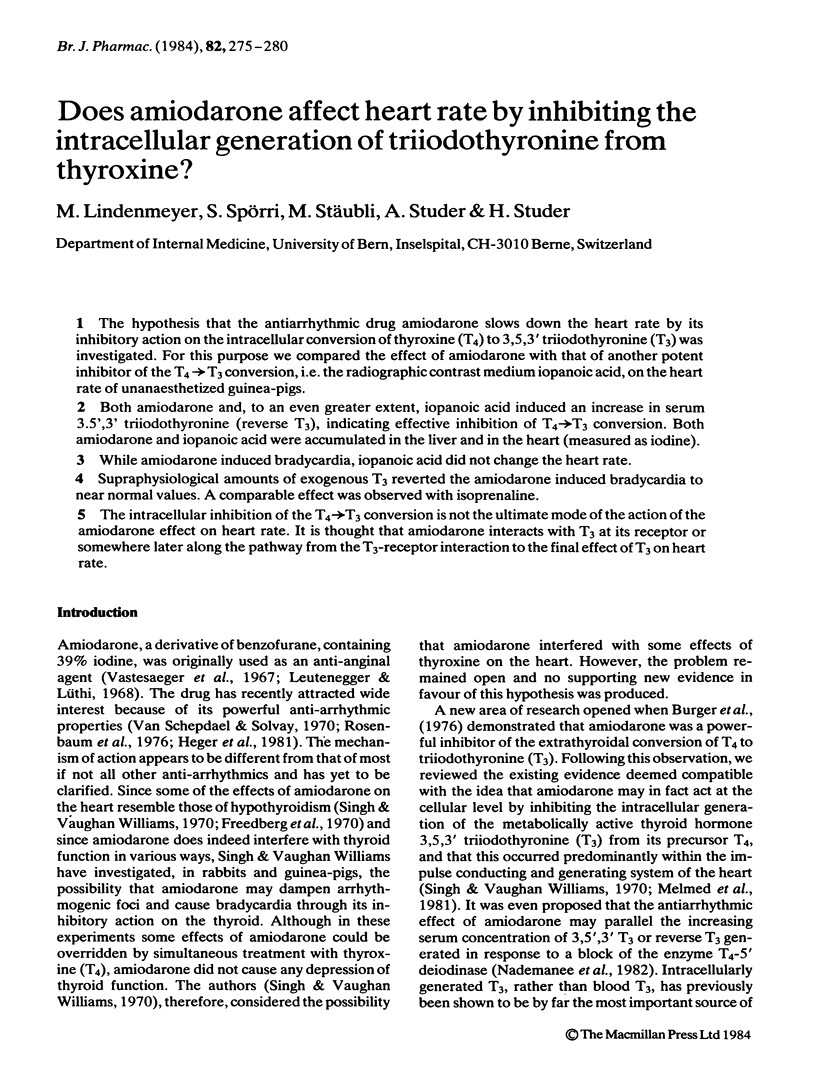
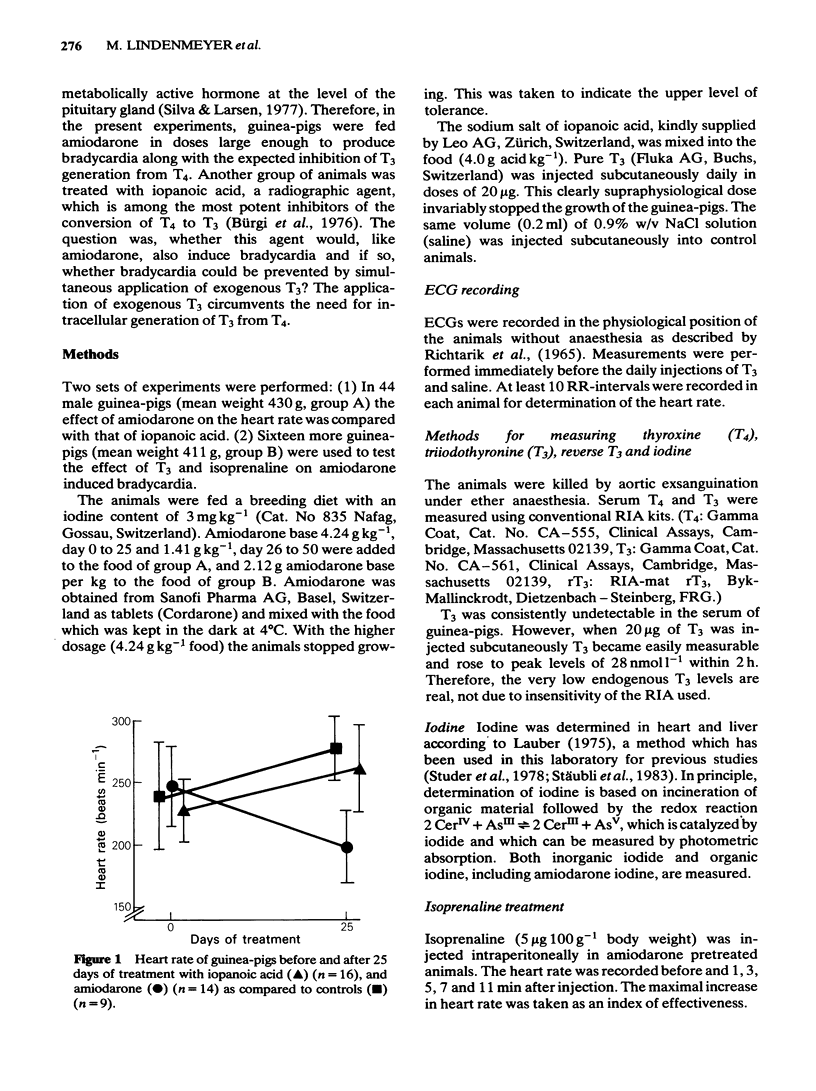

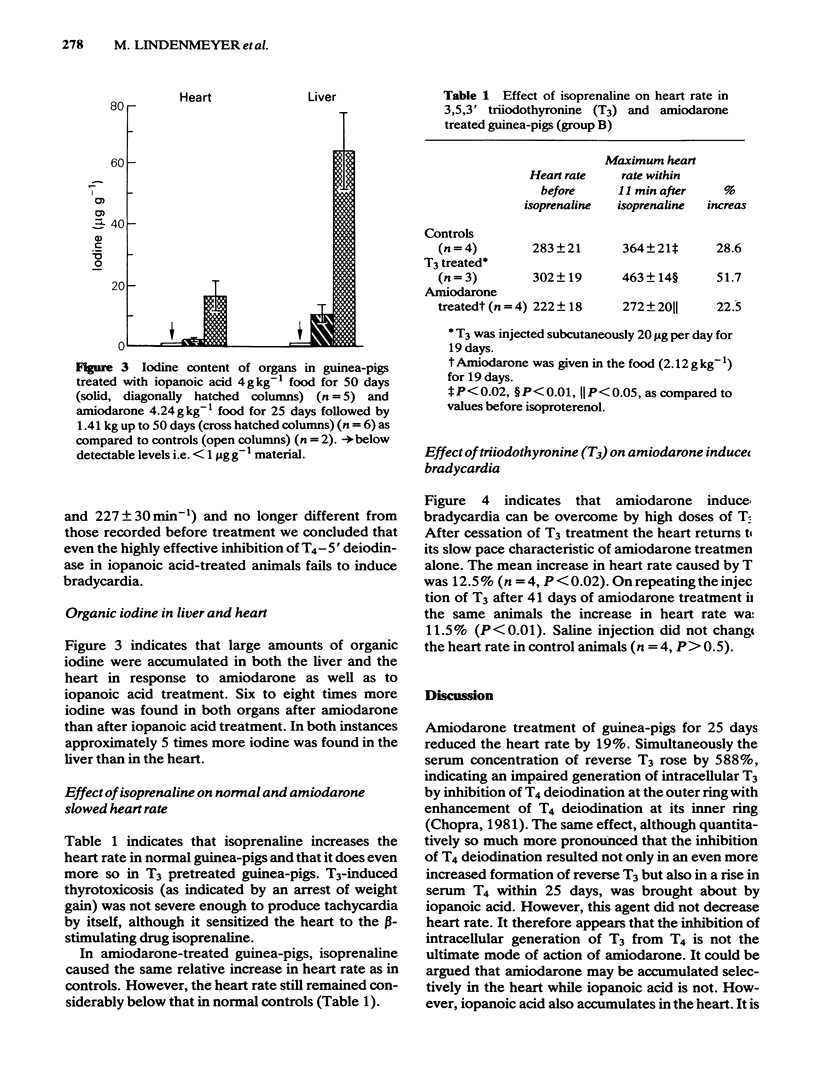
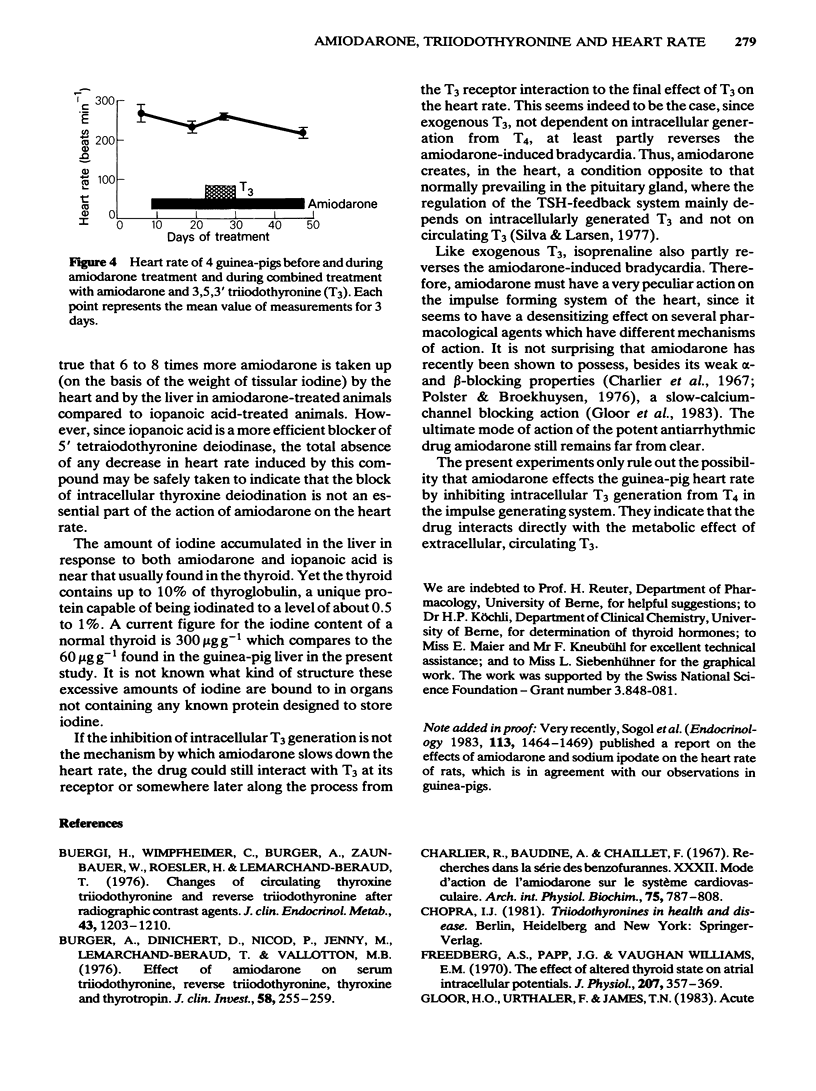
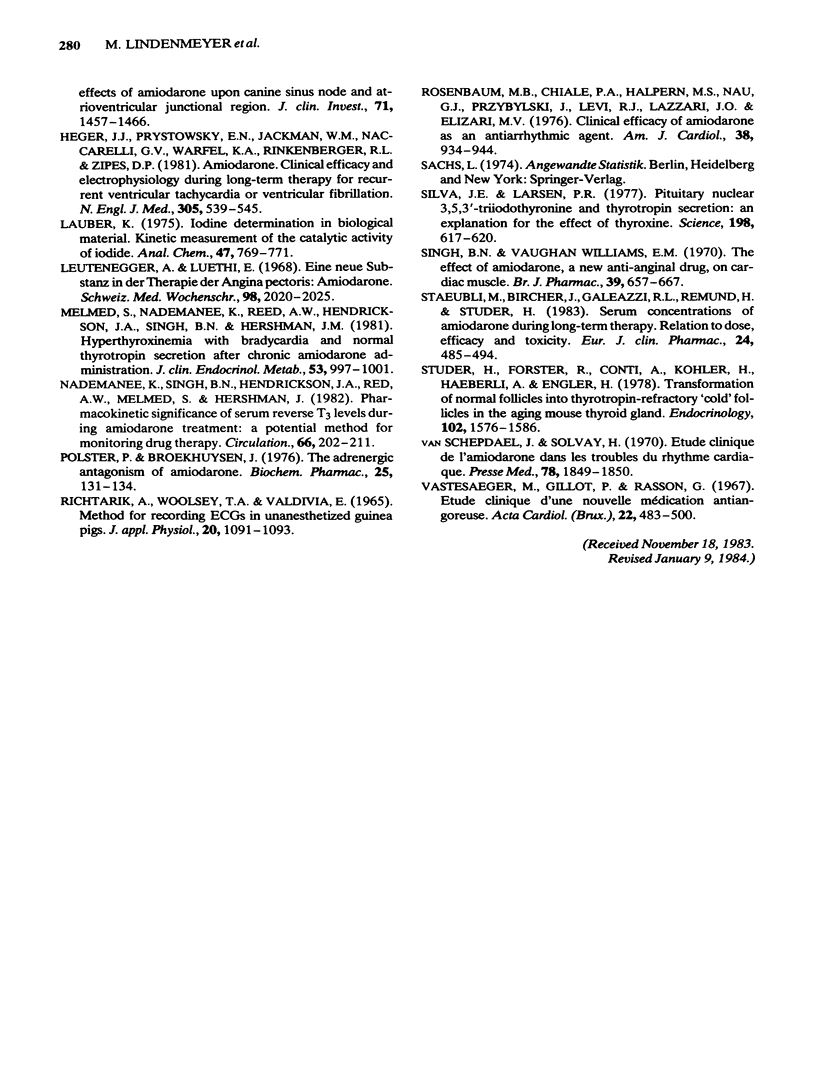
Selected References
These references are in PubMed. This may not be the complete list of references from this article.
- Burger A., Dinichert D., Nicod P., Jenny M., Lemarchand-Béraud T., Vallotton M. B. Effect of amiodarone on serum triiodothyronine, reverse triiodothyronine, thyroxin, and thyrotropin. A drug influencing peripheral metabolism of thyroid hormones. J Clin Invest. 1976 Aug;58(2):255–259. doi: 10.1172/JCI108466. [DOI] [PMC free article] [PubMed] [Google Scholar]
- Bürgi H., Wimpfheimer C., Burger A., Zaunbauer W., Rösler H., Lemarchand-Béraud T. Changes of circulating thyroxine, triiodothyronine and reverse triiodothyronine after radiographic contrast agents. J Clin Endocrinol Metab. 1976 Dec;43(6):1203–1210. doi: 10.1210/jcem-43-6-1203. [DOI] [PubMed] [Google Scholar]
- Charlier R., Baudine A., Chaillet F. Recherches dan la série des benzofurannes. XXXII. Mode d'action de l'amiodarone sur le système cardiovasculaire. Arch Int Physiol Biochim. 1967 Dec;75(5):787–808. doi: 10.3109/13813456709084935. [DOI] [PubMed] [Google Scholar]
- Freedberg A. S., Papp J. G., Williams E. M. The effect of altered thyroid state on atrial intracellular potentials. J Physiol. 1970 Apr;207(2):357–369. doi: 10.1113/jphysiol.1970.sp009066. [DOI] [PMC free article] [PubMed] [Google Scholar]
- Gloor H. O., Urthaler F., James T. N. Acute effects of amiodarone upon the canine sinus node and atrioventricular junctional region. J Clin Invest. 1983 May;71(5):1457–1466. doi: 10.1172/JCI110899. [DOI] [PMC free article] [PubMed] [Google Scholar]
- Heger J. J., Prystowsky E. N., Jackman W. M., Naccarelli G. V., Warfel K. A., Rinkenberger R. L., Zipes D. P. Clinical efficacy and electrophysiology during long-term therapy for recurrent ventricular tachycardia or ventricular fibrillation. N Engl J Med. 1981 Sep 3;305(10):539–545. doi: 10.1056/NEJM198109033051002. [DOI] [PubMed] [Google Scholar]
- Lauber K. Iodine determination in biological material. Kinetic measurement of the catalytic activity of iodide. Anal Chem. 1975 Apr;47(4):769–771. doi: 10.1021/ac60354a023. [DOI] [PubMed] [Google Scholar]
- Leutenegger A., Lüthy E. Eine neue Substanz in der Therapie der Angina pectoris: Amiodarone. Schweiz Med Wochenschr. 1968 Dec 21;98(51):2020–2025. [PubMed] [Google Scholar]
- Melmed S., Nademanee K., Reed A. W., Hendrickson J. A., Singh B. N., Hershman J. M. Hyperthyroxinemia with bradycardia and normal thyrotropin secretion after chronic amiodarone administration. J Clin Endocrinol Metab. 1981 Nov;53(5):997–1001. doi: 10.1210/jcem-53-5-997. [DOI] [PubMed] [Google Scholar]
- Nademanee K., Singh B. N., Hendrickson J. A., Reed A. W., Melmed S., Hershman J. Pharmacokinetic significance of serum reverse T3 levels during amiodarone treatment: a potential method for monitoring chronic drug therapy. Circulation. 1982 Jul;66(1):202–211. doi: 10.1161/01.cir.66.1.202. [DOI] [PubMed] [Google Scholar]
- Polster P., Broekhuysen J. The adrenergic antagonism of amiodarone. Biochem Pharmacol. 1976 Jan 15;25(2):131–134. doi: 10.1016/0006-2952(76)90279-3. [DOI] [PubMed] [Google Scholar]
- Richtarik A., Woolsey T. A., Valdivia E. Method for recording ECG's in unanesthetized guinea pigs. J Appl Physiol. 1965 Sep;20(5):1091–1093. doi: 10.1152/jappl.1965.20.5.1091. [DOI] [PubMed] [Google Scholar]
- Rosenbaum M. B., Chiale P. A., Halpern M. S., Nau G. J., Przybylski J., Levi R. J., Lázzari J. O., Elizari M. V. Clinical efficacy of amiodarone as an antiarrhythmic agent. Am J Cardiol. 1976 Dec;38(7):934–944. doi: 10.1016/0002-9149(76)90807-9. [DOI] [PubMed] [Google Scholar]
- Silva J. E., Larsen P. R. Pituitary nuclear 3,5,3'-triiodothyronine and thyrotropin secretion: an explanation for the effect of thyroxine. Science. 1977 Nov 11;198(4317):617–620. doi: 10.1126/science.199941. [DOI] [PubMed] [Google Scholar]
- Singh B. N., Vaughan Williams E. M. The effect of amiodarone, a new anti-anginal drug, on cardiac muscle. Br J Pharmacol. 1970 Aug;39(4):657–667. doi: 10.1111/j.1476-5381.1970.tb09891.x. [DOI] [PMC free article] [PubMed] [Google Scholar]
- Sogol P. B., Hershman J. M., Reed A. W., Dillmann W. H. The effects of amiodarone on serum thyroid hormones and hepatic thyroxine 5'-monodeiodination in rats. Endocrinology. 1983 Oct;113(4):1464–1469. doi: 10.1210/endo-113-4-1464. [DOI] [PubMed] [Google Scholar]
- Studer H., Forster R., Conti A., Kohler H., Haeberli A., Engler H. Transformation of normal follicles into thyrotropin-refractory "cold" follicles in the aging mouse thyroid gland. Endocrinology. 1978 May;102(5):1576–1586. doi: 10.1210/endo-102-5-1576. [DOI] [PubMed] [Google Scholar]
- Stäubli M., Bircher J., Galeazzi R. L., Remund H., Studer H. Serum concentrations of amiodarone during long term therapy. Relation to dose, efficacy and toxicity. Eur J Clin Pharmacol. 1983;24(4):485–494. doi: 10.1007/BF00609891. [DOI] [PubMed] [Google Scholar]
- Van Schepdael J., Solvay H. Etude clinique de l'amiodarone dans les troubles du rythme cardiaque. Presse Med. 1970 Oct 10;78(42):1849–1850. [PubMed] [Google Scholar]


